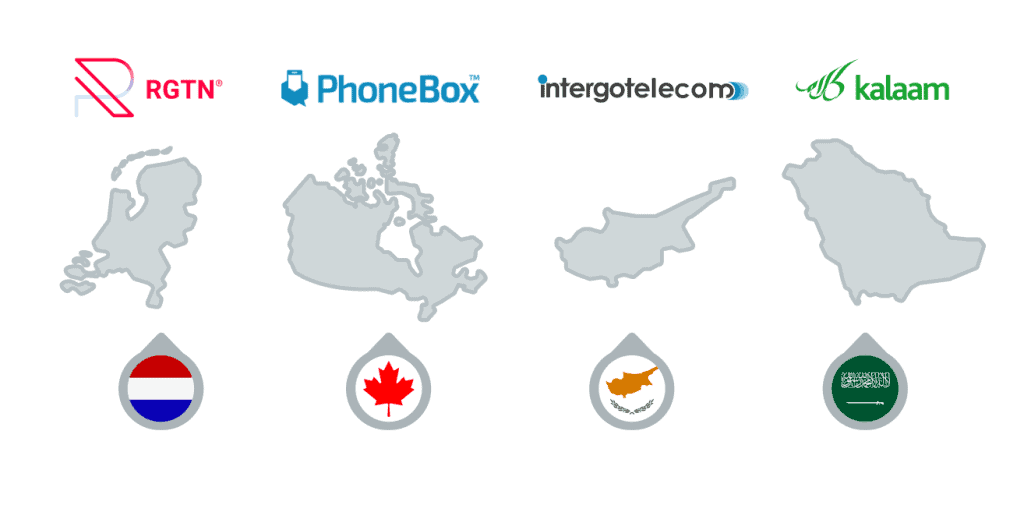Considering expanding your telecommunications business into new established markets? Set yourself up for success with these tips, warnings, and strategies from four members of the PortaOne global customer community who have already blazed the trail.
While the telecom landscape is mature in many countries, millions of consumers and businesses are still eager for innovations and efficiency, making the global telecom market a powerful opportunity for foreign companies. For those ready to translate “business as usual” from their home country into a new territory, untapped opportunities still exist. However, each market presents unique challenges: complex taxation, security mandates, and fierce competition.
Expert Insights for Telecom International Expansion Success
That’s why PortaOne has turned to four members of our global customer community to share key insights and lessons from their experiences with entering established markets. Use these tips to navigate your journey and prepare for success in your new market.
Meet Our Panel of Experts

- Marios Italos
CEO, Intergo Telecom
Cyprus
PortaOne customer since 2023 - Ziad al-Fahad
COO, Kalaam Telecom
Saudi Arabia
PortaOne customer since 2021
Strategies for International Telecom Expansion Success
1. Look for the easy entry points

Starting in a new market doesn’t have to mean starting from scratch. “Our original target market was international travelers in Canada, and we soon realized that our customers need to travel into the US from time to time,” says Sean Sung of Vancouver-based Phonebox. Establishing a presence in multiple territories has allowed Phonebox to offer a consistent cross-border user experience, making it easier for their customers to avoid expensive roaming packages.
Maastricht-based RGTN also found a natural pathway into the US within its existing customer base: large international companies who had sought their help for European operations became an easy sell for similar services in other regions. “We’re a one-stop shop,” says RGTN’s Leonardus Herps. “You want numbers in the Netherlands, you want numbers in the US or elsewhere? Sign here and we’ll take care of everything.”
And don’t forget to look for cost savings. RGTN opened a datacenter in a key location to be close to their major clients, while Phonebox partnered with an MVNE aggregator to simplify their launch in several markets.
2. “Business as usual” in your region can be a unique selling point

Many established markets may seem saturated, but that doesn’t mean there aren’t niches to fill. For both the consumer and B2B markets, “mature” can also mean “stuck in its ways” – which creates plenty of opportunity to bring in a new idea.
“Surprisingly, even in some big and established markets like the US, there are many areas where they are behind. Their services are scattered all over; people are manually inputting data from paper printouts into spreadsheets, even at big firms,” says Herps. “In the Netherlands, we’re known for being highly efficient, so when we come in and show a large company how we can streamline and automate their processes, that’s an edge.” Providing the ability for a business to automatically port a phone number to multiple countries with multiple requirements with just one interface, for example, can be a game changer in an enterprise market used to doing it the hard way.
Cyprus-based Intergo Telecom saw a similar opportunity when launching Telxi to provide numbering and SIP trunking services to the small- and medium-sized business market. “We built and designed a product that caters to the SMB that needs everything to work from day one: inclusive minutes, free DIDs, fixed monthly fees, and as much automation on the Know Your Customer process as possible,” says CEO Marios Italos. “Telxi is successful because we managed to translate those needs through PortaOne with different integrations with outside providers.”
Tip: Bring Your Customer Service A-Game
Our experts agree: when you’re entering a new market – even some big ones like the US – make sure you have sufficient capacity to deliver an excellent experience right to the top of your expected usage range (and beyond). Choose a platform provider that is reliable and that will help you scale quickly if needed, because you don’t want to drop the ball and face outages right at the moment you’re introducing your brand.
Phonebox, meanwhile, is leveraging their international market’s familiarity with eSIM to gain a fast foothold in a product that is only just starting to take off in the US. “We see a lot of potential there,” says Sung. “eSIM will be very dominant in the future.”
Kalaam Telecom, based in Saudi Arabia, capitalized on similar efficiency by expanding its Cloud PBX solutions into Bahrain. “Our goal was to give our customers a solution that integrates easily into their daily operations without needing a complex setup. PortaOne helped us bring a reliable, scalable product to market,” says Ziad al-Fahad. Kalaam’s platform has quickly gained traction in the region, thanks to its simplicity and robust feature set.
3. Choose your challenge: independence or partnership

Start your venture within the “safe harbor” of a larger partner, or go it alone? Both of these paths have plenty of potholes to dodge, so the trick is to map as many of the risks out as you can ahead of time, so you can make the best decision for your specific business.
“We did not want to be a reseller because we did not want to depend on anyone else,” says RGTN’s Herps, citing the fabled story of a provider who gave a large shipping company a phone number only to have their distributor lose access to that number after the shipping company had already painted it on thousands of containers. “If your partner isn’t paying attention, or isn’t doing things in the right way, that can have a major impact.”
RGTN took the harder route with the goal of establishing itself as a full-service operator in the US, complete with “everything save for the radio signalling.” But not every telco has the same resources. For smaller companies that don’t have a lot of liability lurking in their customer base, the reseller or partnership model can be a less risky entry point into a complex landscape.
Since Phonebox, for example, simply wanted to expand the geographical range they can offer to their existing customers – Canadian-based students and travelers – partnering with an MVNE that could provide the infrastructure and carrier interconnects made perfect sense. “Down the road, once we establish a bigger US customer base, we can consider becoming independent there,” explains Sung.
Kalaam Telecom, for instance, leveraged strategic partnerships when expanding into Bahrain. By working with local providers and aligning with PortaOne’s reliable infrastructure, they quickly scaled their services without the heavy lifting of setting up everything in-house. This enabled them to focus on their core offering while ensuring smooth local integration.
4. Always read the fine print

“You have to really watch your step,” warns Herps. “The more you depend on someone, the more they can steer you wherever they want to steer you.” In particular, Herps recommends looking out for exclusivity clauses that might be hiding in your contract. For example, if you’re looking to partner with a third-party vendor who can help you with interoperability with rural legacy systems – which can be a legal requirement in some US regions – that vendor might insist on an agreement that limits you to accepting traffic only through them. “And once you do that, they can do whatever they want, and your dream of being independent is shot to pieces,” Herps says.
Tip: Just Say No
Just because a third-party vendor asks, doesn’t mean you have to agree, says RGTN’s Leonardus Herps: “They’ll keep trying, and they’ll use high-pressure tactics, but just keep saying no.” Remember this tip when signing up for other services, too: “Don’t let them sell your one-person office on a 10-line package, or hook you with minimum commitments.”
And it’s not just hidden contract clauses you need to look out for – there are hidden costs, too. “In the Netherlands, there are government institutions and industry associations that help you with mandated requirements, but in the US it’s all handled by for-profit companies – and if one company corners that service, they’re in a position to take advantage of you, and they can charge you through the roof,” warns Herps. If you don’t want to be stuck with a bad deal, it’s worth investing the time to find a competing vendor, or to dig into the loopholes that will allow you to work around the requirement.
5. Prepare to spend lots of time (and money)

Hiring specialized lawyers to shed daylight on those hidden contract clauses is a must, says Marios Italos. Then, there are the steep cost and time commitments for filing taxes on both the federal and state levels, the long list of certifications you’ll need, and regulations such as STIR/SHAKEN and robocall mitigation you’ll need to be prepared to meet. “There are a lot of requirements and a big administrative load, and that translates into a big upfront cost,” says Italos. “The whole thing is very complicated for someone who is not on the ground.”
The RGTN team, meanwhile, did not expect to encounter such a fragmented process. “It’s not a one-stop shop, where you can go to one office and do it all. There are 100 different things that you need, and nobody knows what they are or what the steps are. You have to figure it out by yourself,” Herps recalls. The security vetting process for RGTN alone took a year and a half. “You register with the FCC, which publishes your request to register as an operator.
Tip: Get Help from Your Friends
Herps notes that having existing relationships with clients and providers was a big asset in navigating all the complicated requirements. That includes choosing partners like PortaOne that have experience operating across multiple countries – the US included – and have been vetted by regulators as trusted partners.
Then Team Telecom (a branch of the US Department of Justice) files an order to put your application process on hold so they can start an investigation.” The organization will look into all of your current and former shareholders, along with each of your partners and interconnects, Herps warns. “Then you go back to the FCC with your proof of all the requirements, then you go to NANP to wait for them to release your number ranges, then the carriers have up to 66 days to pick up on that information. Then, after that, you can start doing business.”
There is a silver lining in all that red tape, however: “The US government is very slow, but you can use that time to go through all your contracts with your vendors and carriers and make sure you are getting into the right deal,” Herps advises. He also notes that telecoms who are willing to start as a reseller can avoid a lot of these delays.
6. Plan out your roadmap – with as much detail as possible

“You have to take into account that highly regulated markets will require you to do a lot of homework,” says Marios Italos. “If you go in without knowing your breakeven point and without a clear plan for reaching that first thousand or ten thousand customers – whatever that breakeven point is – you will soon realize that the regulatory fees and monthly costs just to stay compliant will outweigh the benefits.”
Sean Sung says that Phonebox found itself scrambling in the middle stages of its expansion project because it didn’t plan it all the way through. “Look at the big picture. How do you want to set up your system? Who will be your payment processor? How will you do the taxation?” he says. Challenges like these led the company to give up on trying to adapt their in-house system and instead choosing to partner with PortaOne for their US operations, which would allow them to more easily add capabilities like managing regional taxation (more on that in the next point) and integrating an international calling feature.
And, however much planning you do, you’ll still need to expect the unexpected, says RGTN’s Herps: “We thought we did all our due diligence, but there was a still a point where I thought, ‘What have we done!’
7. Simplify taxation and regulation wherever you can

“Taxation was challenging – it was a bit shocking for us when we realized how many things you need to be aware of,” recalls Sung. For example, in Phonebox’s home country of Canada, taxation is a simple matter of determining which province a customer is located in, while in the US, tax is determined by area code, and rates can change every quarter. “Luckily, PortaOne offered several different taxation solutions that were already integrated, so we just had to choose the ones that were suitable and then easily integrate them with PortaBilling.”
Tip: Don’t Re-Invent the Wheel When You Can Use API
Why hire expensive developers to create a custom fix for your new market operational challenges when you can integrate a tried-and-tested low-code solution in minutes? “Third-party solutions saved us a lot of time in terms of both taxation and payments,” says Sean Sung. “We didn’t have to re-write the system; we just plugged in the API and started using it.”
RGTN also relied on built-in PortaOne taxation capabilities, along with API add-ons to simplify their compliance with STIR/SHAKEN laws, robocall mitigation, 911 emergency support, and more. “The regulators will check to make sure you can support these things – you need to show software support, and you need to show your contract with a provider,” says Herps.
8. Every challenge can be an opportunity

Realizing that their legacy system did not have the flexibility needed to manage the intricacies of US payments and regulation opened a new door for Phonebox – specifically, partnering with PortaOne to start fresh on a brand-new platform. “Before we entered the US market, we had only worked with our own system, which is a bit outdated and quite manual. We didn’t really have any knowledge about how other business support systems worked. It’s been a good experience to see what PortaOne is offering their customers, what their onboarding process is, what their training process is.”
Now, Phonebox is running their new US venture on the PortaBilling real-time billing and charging platform, while retaining their Canadian service on their custom-built legacy system. “It has helped us a lot to work alongside the Boomi workflows developer at PortaOne and get those suggestions and resources on how to best integrate third-party services,” says Sung. Now, Phonebox has the necessary capabilities to be able to offer its travel agency partners the commissions and other perks that help the company stand out.
“We always want to offer new features, and to be able to offer new business logic to our US customers, and now we have that flexibility,” explains Sung.
9. Choose the right partner

With all these challenges, why do so many service providers leap into new markets? It’s simple, says Leonardus Herps: “Bigger market, more money.” Add to that the ability to offer international customers a seamless global experience, and the venture becomes worth the effort – if you do it the right way, and with the right partner.
PortaOne has a long history of helping telecommunications services providers, IoT innovators, and AI agent developers break into new territories. Our customers trust us to give them the tools to navigate complex and changing tax, regulatory, and technological landscapes, while offering the 24/7 support and extensive documentation that helps them tackle all the unexpected challenges that come with expanding into new sectors and unfamiliar markets.
Our partnership with Oracle makes it easy to quickly establish a cloud-based global presence, and our open API philosophy and Add-on Mart marketplace of low-code, white-label services allow you to leverage efficiency drivers like automation, customer self-service, and seamlessly integrated third-party solutions. With our agile, 7-week development cycle, geo-redundancy for high-availability, and no-hidden-cost commitment, we are the BSS provider that can help you launch, scale, and succeed worldwide.
About PortaOne
For over 25 years, PortaOne has helped over 500 telecom providers from more than 100 countries succeed by delivering robust, scalable solutions. Our platform helps businesses launch and manage telecom services in a cost-efficient manner, providing the tools needed to succeed in new and established markets alike.

PortaOne Solutions
- PortaSwitch: Unified service management and delivery
- PortaBilling: Flexible billing with real-time charging
- PortaAIM: Comprehensive AI revenue management
- PortaOne Workflows: Visual iPaaS platform for a seamless technology stack
- PortaPhone: Versatile cloud softphone solution
- Cloud PBX + Call Center: Enhance productivity and CX for SMBs
- IoT Mill: Accelerate the launch of innovative IoT ideas
- PortaOne Add-on Mart: Low-code marketplace of value-added services
FAQ: International Telecom Expansion
STIR/SHAKEN compliance is a US regulatory requirement to combat robocalls, mandatory for telecoms entering the market. RGTN used PortaOne’s API add-ons to streamline compliance, ensuring their platform meets FCC standards for call authentication.
Simplifying taxation in new markets is critical. Phonebox and RGTN leveraged PortaOne’s built-in taxation capabilities to handle complex US tax systems, where rates vary by area code and change quarterly, reducing administrative burdens.
Building successful partnerships involves choosing reliable providers like MVNEs or local carriers. Phonebox partnered with an MVNE for US infrastructure, while Kalaam Telecom collaborated with local providers in Bahrain, supported by PortaOne’s scalable platform.
Adapting to local market preferences ensures relevance in new regions. Intergo Telecom’s Telxi product, with inclusive minutes and automated KYC, caters to SMBs’ needs, while Phonebox used eSIM familiarity to gain a foothold in the US market.
Streamlining and automating processes provides a competitive edge. RGTN automated phone number porting across countries, and Intergo Telecom used PortaOne integrations to simplify SMB services, enhancing efficiency in established markets.
Delivering a strong customer service A-game is vital for new market success. Experts recommend choosing a reliable platform like PortaOne to scale quickly and avoid outages, ensuring an excellent cross-border user experience, as Phonebox achieved.
Avoiding hidden contract clauses is crucial for international telecom expansion. RGTN’s Leonardus Herps warns about exclusivity clauses in vendor agreements, advising thorough contract reviews to maintain independence and avoid costly commitments.
Planning your breakeven point prevents financial pitfalls in international telecom expansion. Marios Italos emphasizes that without a clear roadmap for reaching 1,000 or 10,000 customers, regulatory fees and compliance costs can outweigh benefits.







